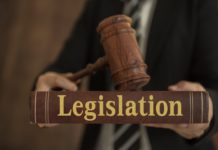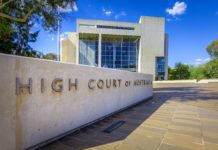Can AAT assess risk to community in advance?
Federal Court. Due to s 500(6L), AAT had 84 days to decide under s 501CA(4) whether to revoke the mandatory cancellation of Applicant's visa. At the time of AAT's decision, Applicant still had about 6 years of imprisonment to serve. Could AAT make a legally reasonable decision about the risk the Applicant would present to the community upon release 6 years in advance? Did AAT have "power to remit the application with a direction, or recommendation, that a decision concerning the application for revocation of the cancellation of the Applicant’s visa be deferred until closer to the time of his release from imprisonment"?
Do consequences of breach of international obligations to Australia matter?
Federal Court. In considering Direction No 79 for the purposes of s 501CA(4), should decision-makers consider the consequences of any breaches of Australia’s obligations under international law not only to the non-citizen, but also to Australia? We summarise the answers to this and several other questions.
Tension between Direction 79 and ss 197C/198
Federal Court. In the context of s 501CA(4), there is a tension between ss 197C and 198 (which require removal even if it would breach international non-refoulement obligations) on the one hand and cl 10.1 of Direction No 79 (which says Australia will not breach those obligations) on the other hand. In XFKR, applicant submitted that AAT had erred by failing to recognise that he would have to be removed from Australia immediately under ss 197C and 198 if the mandatory cancellation of the visa were not revoked. FCA found in XFKR: AAT cited explanatory memorandum, which referred to the Minister’s non-compellable personal power under s 195A; AAT found "that any concern that the applicant might be deported was minimised by the commitment by the Australian government not to refoule"; AAT did not make error. Should XFKR be distinguished?
Minister expected to comply with ministerial direction?
Federal Court. Although the chapeaux in para 12(1) of Direction No 75 and para 10.1 of Direction No 65 refer to a decision whether to cancel a visa, are those paragraphs are about whether to refuse a visa? Although Direction No 75 is not binding on the Minister personally, is it reasonable to expect that the Minister, as a model litigant, would follow the procedure mandated for his surrogates in that direction? Does the prospect of indefinite detention no longer arise by reason of the insertion of s 197C? If so, does that mean that non-refoulement obligations will no longer be considered?
Do Browne v Dunn & hearsay rules apply to AAT decisions?
Federal Court. Rule in Browne v Dunn: "if you intend to impeach a witness you are bound, whilst he is in the [witness] box, to give him an opportunity of making any explanation which is open to him". Does that rule apply to Tribunal decisions? Further, according to the hearsay rule, out-of-court representations made by a person are not admissible to prove the existence of a fact that it can reasonably be supposed that the person intended to assert by the representations, with exceptions. Does the hearsay rule apply to Tribunal decisions? We summarise the answer to these and several other questions.
s 116(1)(e) interpreted
Federal Court. This decision interprets in detail the operation of s 116(1)(e): "... the Minister may cancel a visa if he or she is satisfied that... the presence of its holder in Australia is or may be, or would or might be, a risk to ... the health, safety or good order of the Australian community or a segment of the Australian community".
Family violence: must relationship be genuine? Materiality onus shifted?
Federal Court. Delegate refused second stage partner visa (subclass 100) on the basis of end of relationship. On review at AAT, Appellant made family violence claim. At what point did the requirement to prove the existence of a genuine relationship end? Secretary: issued two s 375A certificates which covered documents that were capable of proving that relationship was genuine; revoked 1 of those certificates; and issued a s 376 certificate. In circumstances where Minister defended a denial of procedural fairness by successfully claiming at FCCA public interest immunity in respect of a document covered by an undisclosed certificate, is the onus to prove that, had the Tribunal not failed to disclose the s 376 certificate, it could have arrived at a different decision, shifted from Minister to Appellant?
Can detailed decision reveal it overlooked evidence?
Federal Court. Can the fact that a decision record is comprehensive, thoughtful and fully footnoted strongly indicate that an item of evidence not referred to in it was overlooked?
Can stigma arising from rape found protection claim?
Federal Court. If a persecution claim is based upon membership of a particular social group, may AAT be required to consider a group definition open on the facts but not expressly advanced by an applicant? If AAT chooses to exercise its jurisdiction more widely than an applicant or the Minister has asked, must it do so according to law? IAA found Appellant did not satisfy s 36(2)(a) on the basis that, as she had only told a few people she had been rapped, there was not a real chance that she would suffer societal discrimination. Did IAA make a jurisdictional error by not asking Appellant why she would not tell others about her rape? Could stigma or discrimination arising from sexual assault give rise to a protection claim?
Can AAT consider criteria not considered by delegate?
In CPJ16, FCA had determined whether AAT could consider criteria within s 501(6) not considered by original decision-maker. Here, delegate had refused to grant protection visa based on cl 866.222. By the time of AAT's decision on review, that provision had been disallowed and thus no longer applied. Question to AAT was whether to remit the matter to Department with a direction that cl 866.222 did not apply or assess for itself the other criteria for the grant of the visa. It chose the latter. Was AAT authorised to do that? With respect, this decision makes no reference to CPJ16, which was on point, although concerning a different provision.





















